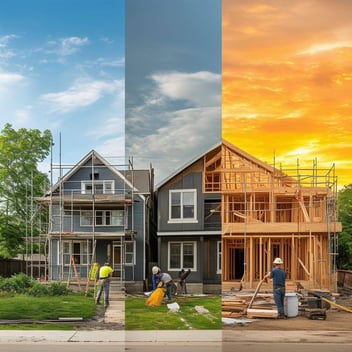3 Min Read
Should you Remodel Your Entire Home at Once or in Phases?
Deciding how to approach a major home remodel is a critical decision for homeowners in Minneapolis. If the scope of your project is significant, it’s helpful to consider whether to complete the renovation all at once or tackle it in phases over time. Both options have their advantages, and understanding the trade-offs between these two timelines will help you determine the best path for your home, budget, and lifestyle.
REMODELING YOUR HOME ALL AT ONCE
Although a full-home remodel requires a larger time and budget commitment, there are several reasons why combining all of the work into one project could be the better option for your home.
COST EFFICIENCY
Pros: While a full-home remodel has a higher upfront cost, it may actually save money in the long run. By completing everything at once, you lock in costs (reducing concerns about inflation), eliminate redundancies, and streamline the entire process. This is especially true when the market is in good condition. Additionally, contractors can bundle labor and material orders, reducing overall costs.
Cons: The initial financial investment is significant, potentially requiring additional financing and/or withdrawals from high-yield savings accounts. Furthermore, a well-planned and executed budget becomes even more important. If unexpected costs arise, there’s less flexibility to spread them out over time compared to a phased approach.
CONDENSED DISRUPTION
Pros: Completing your entire project at once means construction has a clear start and end date, allowing you to return to a fully completed home without ongoing renovations disrupting your life. You’ll avoid dealing with multiple rounds of demolition, dust, and contractor schedules over several years.
Cons: Since everything is being done at once, your family may need to find temporary housing during the construction period. This can be especially stressful for families with small children, pets, or those who work from home.
DESIGN COHESION
Pros: A whole-home remodel ensures a seamless, cohesive design throughout the entire space. Finishes, materials, and styles are chosen together, preventing mismatched updates that can occur with a phased approach. This can enhance your home's overall aesthetic appeal and long-term value.
Cons: A complete remodel requires making all design decisions upfront, which can feel overwhelming. There’s also less opportunity to adjust plans based on how previous phases turn out, as everything is being completed simultaneously.
REMODELING YOUR HOME IN PHASES
For homeowners who prefer a more flexible approach, remodeling in phases can provide financial and logistical advantages. While extending the overall timeline, this method allows for better budget management, adjustments along the way, and the ability to stay in your home throughout the process.
COST FLEXIBILITY
Pros: A phased remodel allows homeowners to spread costs over time, making it easier to budget with a smaller upfront investment. This approach can be especially beneficial if you're financing the project gradually or prioritizing high-impact areas first.
Cons: While spreading costs out may feel manageable, remodeling in stages often results in higher overall expenses due to repeated setup, labor mobilization, and fluctuating material prices. Delaying certain phases also means running the risk of market price increases.
LIVING IN YOUR HOME DURING RENOVATIONS
Pros: One of the biggest advantages of remodeling in phases is that homeowners can often remain in their home while work is being completed. By tackling projects one area at a time, you can maintain functionality in other parts of the house, reducing the need for temporary housing.
Cons: While staying in your home can save on relocation costs, it also means dealing with ongoing construction disruptions, including dust, noise, and limited access to parts of your home. If projects are spread out over a few years, it can feel like you’re always living in a work zone.
FLEXIBILITY IN DESIGN DECISIONS
Pros: A phased remodel allows for adjustments based on how each completed area turns out. You can refine your vision as you go, incorporating new design trends or adapting to changes in lifestyle needs. This flexibility can be helpful for homeowners who aren’t ready to commit to all decisions at once.
Cons: Achieving a cohesive look can be more challenging when remodeling over time. Materials, finishes, and design styles may become discontinued or harder to match, potentially leading to inconsistencies between different phases of the home.
Ultimately, the best remodeling approach depends on your priorities, budget, and tolerance for disruption. A full remodel can offer cost savings and design cohesion, while a phased approach provides flexibility and allows for adjustments along the way. No matter which option you choose, working with an experienced design-build team will ensure a smooth process and a beautifully finished home.
If you're considering a home remodel in the Twin Cities, contact us to start planning your project today.




